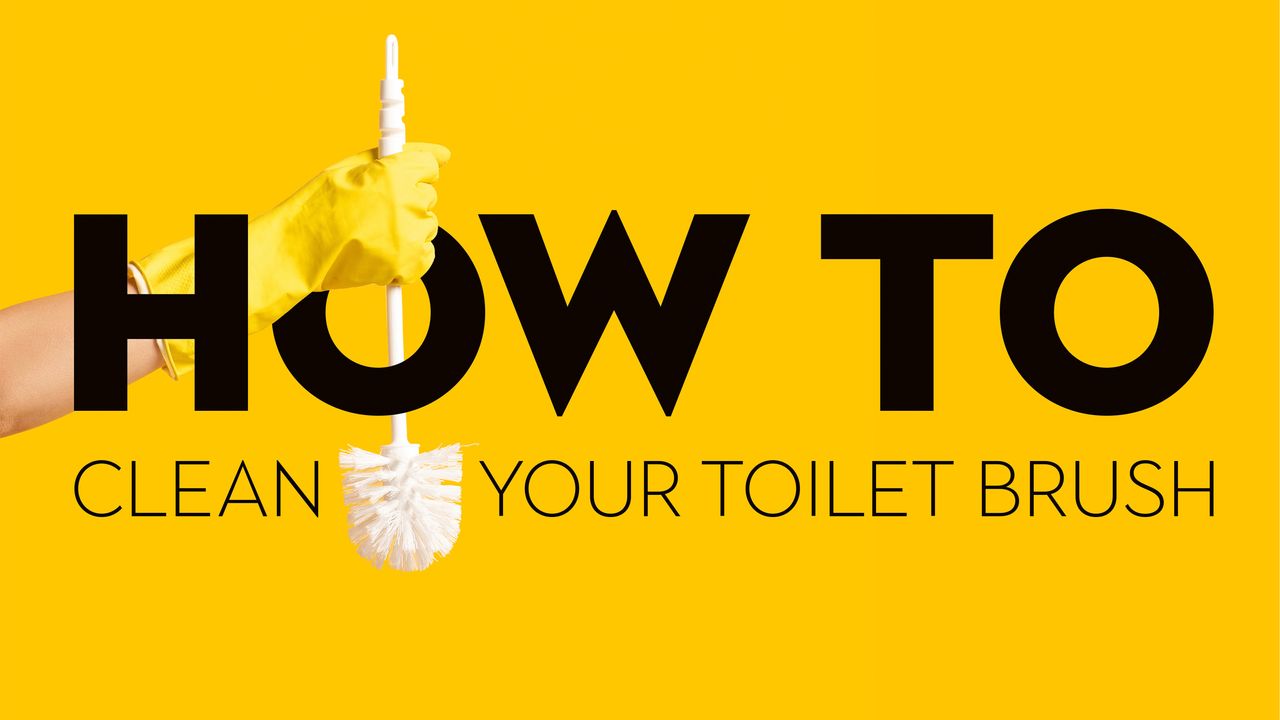

When nature inevitably calls, we’ll all want to know how to clean a toilet brush – but bathroom etiquette and hygiene can seem a bit taboo at times. Skids – streaks – whatever you want to call them are an absolute no-no when it comes to a stylish scheme, especially as we continue to invite family, friends, and guests into our home.
Whether it’s in your downstairs WC, an intimate en-suite, or your main family bathroom, your toilet brush is an important accessory and its duties shouldn’t be pooh-poohed. A practical piece of equipment, this tool, along with the best toilet cleaners, is an essential component of your lavatory experience - and a fundamental part of how to clean a toilet – especially when visiting the restroom for a number two.
Aside from their cleaning abilities, toilet brushes can also be used to unclog a toilet, along with a plunger. After all, if you’re a parent of a young child, you may have experienced them throwing toilet paper and cardboard rolls down the bowl.
Plumbers and external labor can come at a premium price (and a wait), so sometimes it’s best to roll up your sleeves, don some extra-long rubber gloves and get to work yourself.
So 'brush up' on your skills and find out the best way to tackle the waste matter.
How to clean a toilet brush with bleach and hot water
With bleach costing nearly next to nothing, you'll have no excuse making sure your toilet brush is looking spic and span. And, you can rest assured that this is a low-maintenance job that isn't as grubby as you'd think if you follow our instructions carefully.
You will need:
- A filled kettle with freshly-boiled water
- 500ml bleach
- A large bucket (available from Amazon)
- Fill a bucket with hot water – ideally, boil your kettle so it’s super hot. (Make sure the bucket is deep enough to hold enough water to fully submerge the toilet brush and holder).
- Then add two cups (approx 500ml) of bleach into the water.
- Submerge the brush into the bleach water and leave to soak for at least 1 hour – ideally longer. You can do this overnight for ease.
- Finally, rinse the brush and the holder under hot water to remove all the bleach residue – do this for at least 30 seconds.
- Ensure you thoroughly dry the brush and the holder before storing. Storing a wet or damp brush will result in bacteria growth.
How to clean a toilet brush with concentrated detergent
You will need:
- Hot water from a tap or freshly-boiled kettle (available from Amazon)
- Bucket
- Rubber gloves
- Toilet brush
- A bottle of Zoflora 3-in-1 concentrated multipurpose disinfectant or an equivalent disinfectant
'Given what it’s designed to, it’s no surprise that [a toilet brush is] a haven for viruses, bacteria, and unpleasant odors to develop,' says Louise Fox, head of international marketing at Zoflora.
'To eliminate those hidden nasties, fill the holder or a bucket with diluted Zoflora (per product instructions) and allow the brush to soak for at least five minutes.'
And it doesn't stop there. Discussing how to clean a bathroom from top-to-toe, Cleanfluencer Sophie Hinchcliffe aka Mrs. Hinch says: 'I pour a neat capful of Zoflora into my toilet brush once it has been cleaned and disinfected just to keep the smell fresh!'
So if you want to follow Hinch's hunch on how to clean a toilet brush, pop Zoflora in your Tesco online shop, or if you're stateside, Lysol, (available on Amazon) is the closest American alternative.
How to clean a toilet brush holder
'Your toilet is a staple in the family home and keeping it in great condition requires an arsenal of tools to ensure proper hygiene,' says Juliette Bandinu, brand manager, Harpic.
'Often, the first toilet cleaning tool that comes to mind is the trusty toilet brush. However, overuse can leave you with a dirty toilet brush so it’s important to give it a little TLC every once in a while to ensure you get the best toilet clean.'
'It’s easy to forget about the toilet brush holder but it is an important area to clean. Drips and splashes of dirty toilet water can make your brush holder the perfect home for germs, grime, and dirt. All you have to do is rinse the holder with clean, hot water and wipe down with a clean cloth. Repeat this as many times as necessary.'
How to clean a toilet brush with rubbing alcohol
'Your toilet brush takes care of some of the most undesirable messes imaginable,' says Melissa Maker, entrepreneur, cleaning expert, founder of Toronto’s most popular boutique cleaning service, and star of the Clean My Space channel on YouTube.
'The number 1 rule for taking care of it is to prevent what you’re cleaning out of your toilet from hanging out on this brush or in its little storage cup,'
'After cleaning the toilet, rest the brush between the bowl and the seat. Spray it generously with a disinfectant, such as rubbing alcohol, and let it sit, dripping wet, for 10 minutes or so. Then, rinse the brush in the hottest water possible and allow it to drip dry again, using the same method. Never place a wet brush back into the brush cup—that’s when the paranormal activity starts to happen!'
'The brush cup can also be cleaned by spraying it with disinfectant, leaving for 10 minutes, and rinsing under hot water.'
Using a disposable toilet brush
While not the most eco-friendly bathroom option, disposable toilet brushes are an option if you have young children who like to, err... Play with everything and anything.
Brushes with one-use or removable heads or sponges, like the ones from Clorox, available at Amazon are perfect for making sure you're little one isn't using a dirty brush as a toy. Simply purchase refills and replace them when the individual unit is soiled.
What is a toilet brush made of?
In terms of the brush itself, standard plastic bristles are most common, but silicone is being used more often and can have superior cleaning properties. This is because the soft and malleable bristles make it easier to remove fecal matter and other mess.
Holders can be made from all sorts of materials including ceramic porcelain, stainless steel, wood, plastic, and even processed strengthened glass. However, all are relatively easy to clean and hygienic whichever you choose.
Secondary to removing excrement, they should all repel odors as well. Generally, steel and porcelain will be slightly longer-lasting in terms of the time you'll have before replacing your toilet brush. Some people think they look more aesthetically pleasing in this environment. While plastic versions are a little cheaper, they may not suit your decor – especially if you're looking for luxury bathroom ideas.
How to buy a toilet brush
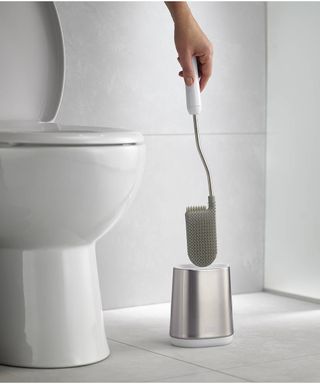
Toilet brushes and holders
There are two options you have when investing in this restroom staple. You can either buy standalone toilet brushes or brushes where the holder is included. If you don't have a holder already, you'll want to pick one up, for the most sanitary experience.
These accessories are shaped to contain brushes neatly and hide the bristles from unsavory views. So what can be a slightly jarring sight, will be hidden away behind a chrome, colored, or a pure white cover.
Mount types for toilet brushes
Another thing to consider is whether you want a freestanding or wall-mounted toilet brush – decisions, decisions! From a bathroom storage perspective, wall-mounted toilet brushes can be a more ergonomic option, as you can place them at a comfortable height so that no one in the family has any excuse not to keep a well-kept water closet, as there's no need to bend down or reach high to pick up the brush. The distance between the toilet and the holder can be reduced as well. So the possibility of germy drips and bleachy-scented spills is lower. Then again, you might prefer the convenience of freestanding holders which can be tucked away and moved for cleaning. If you get toilet brushes for each bathroom, then you can go with either mounting type.
Toilet brushes and bathroom sets
Do you want to buy a toilet brush or a bathroom set? If you're replacing your bathroom furnishings completely or decorating a new bathroom, then it's better to pick up a brush, holder, and toilet roll holder at the same time, for ease at the very least. Some sets even come with plunger accessories, giving you a wider range of cleaning options should you have to deal with a blocked toilet. Getting all your accessories in one delivery order can be more convenient, cost-effective, and ensures there's no sudden issue with stock.
Space-saving toilet brushes
The bathroom isn't usually the largest room in the home. That's why it makes sense to use the space efficiently. This even applies to small products like toilet brushes. Trust us, all those niggly cleaning products can add to clutter and become quite a nuisance, even if you know how to organize under the bathroom sink and have made ample space for these. Wall-mounted brushes can help free up floor space for small bathroom users. Choose slimline brushes and holders for small guest bathrooms.
Types of toilet brush
Considering what they are used for, there is a wide selection of restroom brushes available on the market. From plastic to stainless steel and silicone, each has its pros and cons. Whatsmore, choosing a material that blends in with the rest of your interior is just one way to ramp up your restroom if you're wondering how to improve your bathroom without remodeling it.
While plastic is the budget-friendly brush choice, typically speaking, it may have to be changed more often. Stainless steel is a perfect rust-free option for a modern bathroom. And, silicone has been promoted by the likes of Lynsey Crombie aka Lynsey Queen of Clean.
Recommending the ASOBEAGE Toilet Brush, available on Amazon, she says: 'The toilet brush is back down in price. Slimline, silicone, D-shaped.'
While Becky Rapinchuk aka Clean Mama has another option from a leading brand. She says: 'I chose the OXO Good Grips Hideaway Compact Toilet Brush + Holder, available on Amazon for a few reasons.'
'It’s compact, it stays open when the brush is out (no touching the holder), the brush can be replaced and it's small and unobtrusive. Here's how I use our toilet brushes and avoid the gross factor:'
Why do you need a toilet brush?
While bowel movements vary from person to person, it’s estimated that the average person poops on average once a day (depending on diet, age, activity levels, etc), so your bathroom is no doubt a high-traffic area in the home.
While a normal toilet flush and the pressure of the cistern circulating the water should in theory get rid of those familiar brown smears, sometimes, our porcelain bowls need a little extra help, when taking a comfort break.
Therefore, the toilet brush, with its characteristic bristles, works as an abrasive sweeper to lift organic material and debris off your throne, along with your best cleaning products.
How often should you clean a toilet brush?
'Brushes should be disinfected every three to six months – at least!' advises James Chapman, director at Bella Bathrooms.
'If you have a thriving, flourishing household, you may be required to do so more often. How often you clean your brush is really at your discretion. However, a well-maintained brush will work far better than one that’s bristles are falling apart. Schedule in regular cleans to ensure that you don’t bypass this important process.'
'Invest in an anti-bacterial toilet cleaner that has been specially formulated to deal with the dirt and fecal matter that toilet brushes are forced to come into contact with. As we know, bathroom toilets are hotbeds for contamination. So the appropriate anti-bacterial cleanser will nullify the nastiest germs that are potentially living and breeding in your brush!'
How to clean a toilet brush without harsh chemicals
'You can also put together your own concoction (vinegar) and simply soak the brush in its own holder,' says Chapman.
'Overusing bleach is not environmentally friendly, so if you do have vinegar to spare, it works just as well and the environment approves. We prefer to squirt product into the toilet bowl and let the brush soak there (only if the toilet itself has been cleaned of course). Alternatively, place the brush into a bucket, apply your vinegar with some hot water and allow to soak for an hour minimum.'
'If you are soaking your brush in the toilet bowl, you will need to leave it to soak for several hours. The benefit is you will also have a brand spanking new toilet as well as brush! After a vigorous, soothing soak, you should rinse your brush once more with a hosepipe or by bucketing clean water onto it and allow it to air dry.'
Join our newsletter
Get small space home decor ideas, celeb inspiration, DIY tips and more, straight to your inbox!

Hi, I'm the former acting head ecommerce editor at Real Homes. Prior to working for the Future plc family, I've worked on a number of consumer events including the Ideal Home Show, Grand Designs Live, and Good Homes Magazine. With a first class degree from Keele University, and a plethora of experience in digital marketing, editorial, and social media, I have an eye for what should be in your shopping basket and have gone through the internal customer advisor accreditation process.
-
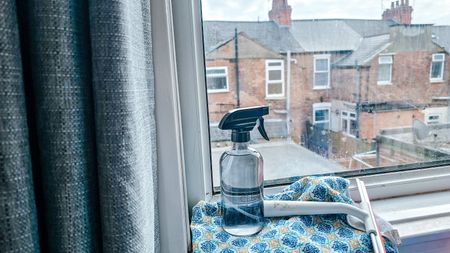 How to clean windows without streaks — 5 easy steps that cleaning pros always follow
How to clean windows without streaks — 5 easy steps that cleaning pros always followThis method on how to clean windows is favored by professional cleaners. We've asked them for the steps you should follow, plus picked cleaning buys
By Eve Smallman Last updated
-
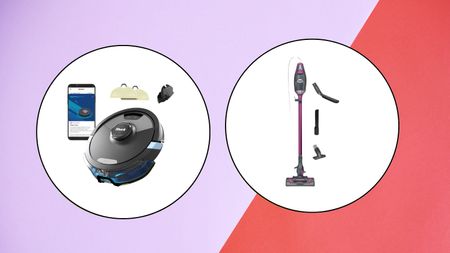 The latest Shark sale deals are perfect for pollen-proofing your home — with up to $150 off our favorite vacuums
The latest Shark sale deals are perfect for pollen-proofing your home — with up to $150 off our favorite vacuumsWe found the latest Shark sale deals on vacuums that are sure to be swooped up, especially as spring blooms trigger pollen allergies and we're in need of extra cleaning
By Danielle Valente Published
-
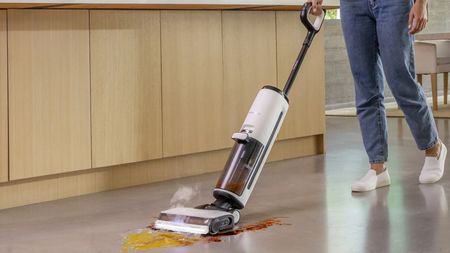
 Tineco Floor One S7 steam wet-dry vacuum review — spotless floors with minimal effort
Tineco Floor One S7 steam wet-dry vacuum review — spotless floors with minimal effortOur contributing editor, Camryn Rabideau, tests the Tineco Floor One S7 steam wet-dry vacuum in her New England homestead property
By Camryn Rabideau Published
-
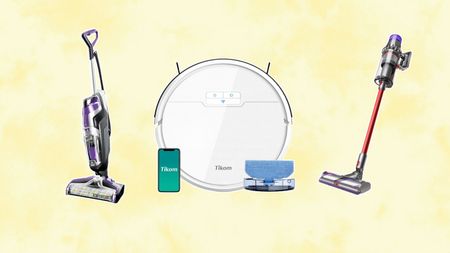 Amazon vacuum cleaners to nab during the retailer's Big Spring Sale — save up to 60% off our go-to small-space finds
Amazon vacuum cleaners to nab during the retailer's Big Spring Sale — save up to 60% off our go-to small-space findsChecking out the savings on Amazon? Vacuum cleaners are a must-buy during their first Big Spring Sale — here are our favorites up to 60% off
By Danielle Valente Published
-
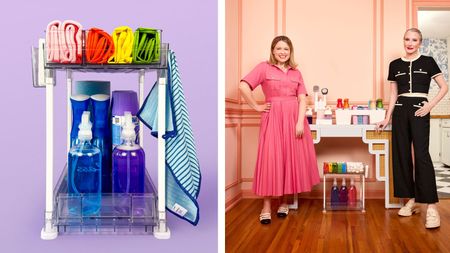 The Home Edit Walmart cleaning collection has just debuted with finds from $3
The Home Edit Walmart cleaning collection has just debuted with finds from $3Spring cleaning, anyone? The Home Edit Walmart cleaning collection has hit shelves with picks from $3
By Danielle Valente Published
-
 How to clean carpet on stairs — 3 simple steps to a spruced up staircase
How to clean carpet on stairs — 3 simple steps to a spruced up staircaseWant to know how to clean carpet on stairs? Our experts explain the simple steps to a sparkling stairway without too much elbow grease
By Andy van Terheyden Published
-
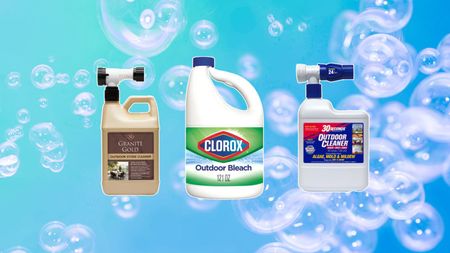 The Home Depot backyard and patio cleaning supplies we're stocking up on before spring
The Home Depot backyard and patio cleaning supplies we're stocking up on before springDon't forget the outdoors when spring cleaning — The Home Depot backyard and patio cleaning buys from $11 will assist with tidying up
By Danielle Valente Published
-
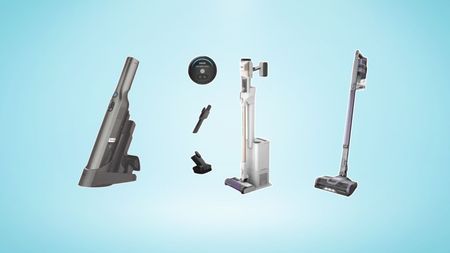 The Shark Detect Pro vacuum and other models are on sale for St Patrick's Day — perfect picks for your spring clean
The Shark Detect Pro vacuum and other models are on sale for St Patrick's Day — perfect picks for your spring cleanWhether you're eyeing the Shark Detect Pro Vacuum or Shark Pet Cordless Stick Vacuum, shop the St. Patty's Day sale for a discount on the best vacuums on shelves
By Danielle Valente Published